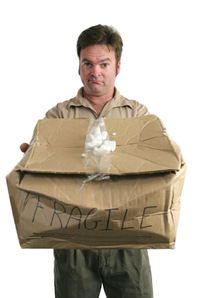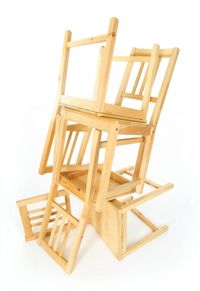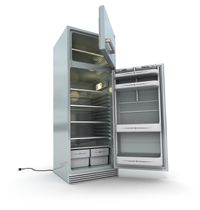Packing what you store
 Once you’ve chosen a storage facility and know what you want to put there, the next stage is getting it ready for the big move. Items have to be packed carefully to prevent damage in transit, or when piled up in the storage unit.
Once you’ve chosen a storage facility and know what you want to put there, the next stage is getting it ready for the big move. Items have to be packed carefully to prevent damage in transit, or when piled up in the storage unit.
Boxed Items
- Use boxes that you’re sure are sturdy — either specially designed ones bought from a storage firm, or fruit cartons picked up at the supermarket to save money. Do NOT use old ones that are on the verge of coming apart, or resemble the picture to the left.
- Using good boxes means you can then fill them to capacity, and stack them in piles without causing a Himalayan avalanche of damaged possessions. Putting the heaviest boxes at the base also makes this less likely.
- Arrange your storage space to have an aisle running down the middle of it, so you have easy access to things on either side.
- Give each box a number or description, so you can later recall what each contains.
- Write a list, or draw a plan, that tells you what you’ve stored in each box and where it can be found.
Fabrics/Soft Furnishings
- A wardrobe box (or several) is a good way of storing clothes so they keep their shape.
- Mattresses and sofas shouldn’t have large objects placed on top of them, however accustomed they were at home to bearing a heavy load each evening.
- Put a moisture absorber in with any fabrics that are being stored to prevent a potentially damaging build-up.
Furniture
-
Provide sofas, chairs and beds with a protective cover; specially shaped ones for each
 type of item are usually available from the storage firm.
type of item are usually available from the storage firm. - Tables and other furniture that have large corners should have them protected by cardboard shields that are available from most storage companies.
- Furniture with storage space inside it (cupboards, bookcases etc.) should be used to contain smaller items rather than being left empty.
- Stack small chairs seat-to-seat, as though you’re back at primary school, to make them take up less floor space.
Delicate Objects
- Anything glass should be wrapped in bubble-wrap or tissue paper to protect it in transport and storage; this helps avoid unnecessary cracks, smashes and marital breakdowns.
- Buy all the materials in advance and pack the objects up at home before bringing them to your unit, especially if there are a lot of traffic lights and sleeping-policemen en route there.
- Pictures or mirrors need special care: ideally, they need to be wrapped in tissue paper and supplied with foam corners, before being stored flat in boxes that say ‘fragile’. Do not put them either on top of a large pile or beneath something heavy.
Appliances/Machinery

- Clean everything before putting in storage, especially outdoor items which may have been kept in quite a dirty state at home.
- If your unit lacks temperature control, then anything that goes in wet may cause condensation that will affect the rest of your items. So be careful to dry everything.
- Freezers, refrigerators and washing machines should be drained for two days before the move. Leave doors left open for ventilation
General
- Stack your possessions close to any outside walls, but not too close. A gap aids the circulation of air. Of course, not every storage unit will have an outside wall, so ask your sales assistant if this is the case.
...Finally, when everything you wish to put away has been meticulously boxed, stored and bubble wrapped to within an inch of its life, make sure you cover everything with dustsheets. Otherwise you will have to brush the accumulated layers of dust off everything individually when you come to remove items from the unit. Then, if all this advice has been followed, you should be able to padlock the door and forget about what’s behind it for however long you wish to, safe in the knowledge that your precious belongings will be in just the same condition upon your return.
